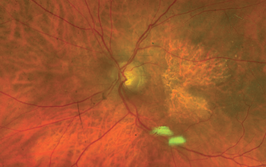How Much Statistical Expertise Does an Ophthalmologist Really Need?
Peer reviewers should insist that tricky statistical techniques are explained clearly to non-statisticians.

Renato Lisboa and his co-authors (1) published a paper earlier this year that examined what statistical techniques are employed in the ophthalmology literature. The Ophthalmologist reported on it at the time of publication (2), but briefly, the study authors found that a wide variety of statistical techniques are reported in the ophthalmological literature, and concluded that “readers of clinical journals in ophthalmology need to have substantial knowledge of statistical methodology to understand the results of studies published in the literature”.
So just how much statistical knowledge do ophthalmologists need?
As with so many other things in medical statistics, the answer is: it depends. I really don’t believe that it is essential for most clinicians to be experts in statistics, but there are certainly times when some statistical knowledge can be handy.
Insist on an adequate explanation
Do you really need to be well-acquainted with all of the statistical techniques used in the paper to understand it, as Lisboa et al. insist? It’s reasonable for authors of clinical publications to assume that their audience is familiar with basic statistical tests, such as the t-test or the chi-squared test – if a reader doesn’t then their ability to critically appraise most of what they’re reading is in doubt.
I dispute the assumption that ophthalmologists need to understand almost all of the statistical techniques used in the literature. They shouldn’t have to. I would argue that there is an onus on the authors of any publication to ensure that their papers are understandable for their intended audience. If you are writing a paper for a clinical ophthalmology journal, and you happen to have used a multivariate random parameter logistic regression model to analyze your data, you really ought to know that most of your readers won’t be familiar with multivariate random parameter logistic regression models. It is up to the authors of that paper to make sure that the rationales for both the statistical test and the interpretation of its results are clearly explained, in order that a non-statistician can follow what is happening. If the authors do not do that, then it is up to the peer reviewers and journal editors to insist that it is done.
The reality of peer review
Now, of course authors of papers ought to explain complex statistical techniques, but the reality is that this doesn’t always happen. Lisboa and his colleagues make the entirely valid point that it’s generally not a sensible strategy to assume that a paper that has been peer-reviewed must have impeccable statistical analysis. If you don’t understand the statistical methods in a paper, perhaps the peer reviewer doesn’t either… and will they admit it? If they don’t, then it’s likely that flaws will go undetected (3). This presents a real challenge for clinicians who are not expert in statistics when faced with a (hopefully rare) paper that describes a study that employed complex statistical methods and explains them poorly in the methods section.
Of course, you may be the person performing that research. If, for example, you were performing a mid-scale clinical trial, would you consult a statistician beforehand? This is one case where you really would have to have a statistician’s comprehensive understanding of all of the appropriate statistical methods, before you even start performing the trial. Teaming up with a statistician is one of the first steps most people would take. So if you’re presented with a paper that contains hard-to-interpret statistics, consider teaming up with a statistician in this context too.
A binocular understanding
One little bit of statistics that I think all ophthalmologists should be familiar with is the concept of independent data points. Many common statistical tests, such as the t-test or the chi-squared test, make the assumption that all of the data points being analyzed are independent of each other – for example, knowing the value of the data for your twentieth data point doesn’t tell you anything about what your twenty-first data point might be.
In many ophthalmology studies, that assumption does not hold. In any study in which the eye, rather than the patient, is the unit of analysis, you immediately have non-independent data points if you include both eyes from a single patient. Chances are that whatever you’re measuring, be it intraocular pressure or lens opacity, of a given patient’s left eye will be quite similar to that of the same patient’s right eye. In other words, the measurements from the two eyes are not independent.
If only a single eye is included from each patient, then this isn’t a problem. But if you have more eyes than patients in a dataset, then the statistical analysis must take account of the non-independence of eyes. There are various ways to do this, such as random effects regression analysis (sometimes known as repeated measures or mixed models). But the problem of non-independence should not be ignored in the paper, and if it seems that it has been, then the results may not be trustworthy.
There are no short cuts to statistical nirvana
So what do you do if you feel your statistical knowledge could use some improvement? My top tip would be: don’t expect to become an expert overnight. Learning statistics is complicated, and it is best done gradually over a long period of time. There are many statistics courses out there, many of which are very good. There are also plenty of excellent textbooks on statistics written for the non-statistician, and of course there is a plethora of information on the web.
However, don’t go to a one-day course, or read a textbook with a title that claims that it will rapidly teach you all of statistics, and expect to come away from it as an expert. Read some more papers, try to engage with them, try to understand a bit more than you did before, and figure out what you still don’t understand. Then when you go on your next course, or read your next bit of a textbook, try to clarify points you hadn’t yet understood. Repeat as necessary.
In summary, it is not necessary for ophthalmologists to be experts in statistics, and much of the ophthalmology literature can be perfectly accessible to clinicians with a reasonably basic training in statistics. Teamwork is an essential feature of the modern research environment, and there will be times when clinicians will need to collaborate with statisticians if they want to make sense of the literature. But for those who wish to take the time to improve their statistical knowledge, there will undoubtedly be rewards in the range of papers that can be easily understood.
Adam Jacobs is Senior Principal Statistician at Premier Research, Wokingham, UK.
Quick quiz
Which is a statistical test?
a) Chi-square test
b) Logarithms
c) Truth table
d) Slide rule
What is the most commonly used statistical measure of spread in a normally-distributed population?
a) Variance
b) Standard deviation
c) Covariance
d) Z score
In a study, vitreous samples were measured for fibronectin in dogs with vitreomacular traction and in healthy controls. How would you compare the concentrations between these two groups?
a) Chi-square test
b) Independent t-test
c) Paired t-test
d) ANOVA
The goal of a study is to compare interleukin-8 levels between patients with early AMD, advanced AMD and healthy controls. What test should you use?
a) Chi-square test
b) Independent t-test
c) Paired t-test
d) ANOVA

- R. Lisboa, D. Meira-Freitas, A.J. Tatham, et al., “Use of Statistical Analyses in the Ophthalmic Literature”, Ophthalmology, 121, 1317–1321 (2014). doi: 10.1016/j.ophtha.2014.01.015.
- M. Hillen, “Stats on stats”, The Ophthalmologist, 4, 13 (2014).
- A. Jacobs, “Breast cancer screening and peer review”, available at: dianthus.co.uk/breast-cancer-screening-and-peer-review, accessed August 12, 2014.

Adam Jacobs is a Senior Principal Medical statistician at Premier Research, Wokingham, UK.













